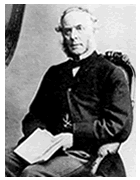Robert Fortune facts for kids
Quick facts for kids
Robert Fortune
|
|
|---|---|
 |
|
| Born | 16 September 1812 |
| Died | 13 April 1880 (aged 67) London
|
| Known for | Introducing many plants to Europe, Australia and America |
| Scientific career | |
| Fields | botanist, plant hunter |
| Institutions | Royal Botanic Garden Edinburgh, Horticultural Society of London |
| Author abbrev. (botany) | Fortune |
Robert Fortune (born September 16, 1812 – died April 13, 1880) was a Scottish botanist and an amazing plant hunter. He traveled far and wide, especially to China and Japan. He is famous for bringing about 250 new and beautiful plants to gardens in Britain, Australia, and the USA. He also helped start the big tea industry in India during the 1800s.
Contents
Robert Fortune's Early Life
Robert Fortune was born in a place called Edrom in Scotland. After finishing his training, he worked at a house near Edinburgh. Later, he got a job at the Royal Botanic Garden Edinburgh.
In 1840, Robert and his family moved to London. He started working at the Royal Horticultural Society's garden. After a peace agreement called the Treaty of Nanking in 1842, the Horticultural Society asked him to go on a three-year trip. His mission was to collect plants in southern China.
Adventures in China: A Plant Hunter's Journey
Robert Fortune's travels brought many new and beautiful flowers and plants to Europe, Australia, and the USA. His most famous achievement was bringing Chinese tea plants to India. This happened in 1848, and he did it for the East India Company. He also brought skilled tea makers from China to India. Robert Fortune worked in China for several years, from 1843 to 1861.

Like other European travelers back then, Fortune sometimes dressed up as a Chinese merchant. He did this on some of his trips outside the main port cities. This was because buying tea plants was not allowed by the Chinese government. Also, his travels often took him further than Europeans were usually allowed to go from the port areas. Fortune visited parts of China that few Europeans had ever seen. These included faraway areas in Fujian, Guangdong, and Jiangsu provinces.
Bringing Tea to India
Fortune used many ways to get plants and young tea plants from local growers. At that time, countries didn't have laws about who owned natural resources like plants. He also used special portable greenhouses called Wardian cases. These cases helped keep the plants alive during their long journey. It is also said that he hired skilled Chinese workers to go to India. These workers helped the East India Company start its tea farms.
Most of the Chinese tea plants Fortune brought to India did not survive. This was partly because the British liked a strong, dark tea. This type of tea was best made from a local Indian tea plant called Assam tea. However, the methods and knowledge that Fortune brought from China were very important. They helped the tea industry grow in Assam and Sri Lanka later on.
More Discoveries and Legacy
On later trips, Robert Fortune visited Taiwan and Japan. He learned about how silkworms are raised and how rice is made. He introduced many trees, shrubs, and flowers to the West. These included the kumquat fruit, a climbing yellow rose, and many kinds of tree peonies, azaleas, and chrysanthemums.
A climbing white rose he brought from China in 1850 was named R. fortuniana in his honor. This rose is still grown today in places with warm winters. It is also used as a strong base plant for other roses in Australia and the southern United States.
Robert Fortune wrote several books about his travels and discoveries. He passed away in London in 1880. He is buried in Brompton Cemetery.
Fortune is remembered for bringing a huge number of plants, shrubs, and trees from China to Europe.
Plants Named After Robert Fortune
Many plants have been named after Robert Fortune to honor his work:
|
|
In 1913, two botanists named Rehder and E.H.Wilson named a plant group from China after him. This group is called Fortunearia sinensis.
Books About Robert Fortune
- For All the Tea in China: How England Stole the World's Favorite Drink and Changed History. By Sarah Rose. Viking: 2010. ISBN: 0670021520
- Robert Fortune, A Plant Hunter in the Orient. By Alistair Watt. Royal Botanic Gardens, Kew: 2017. ISBN: 1842466194
See also
 In Spanish: Robert Fortune para niños
In Spanish: Robert Fortune para niños

